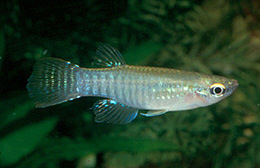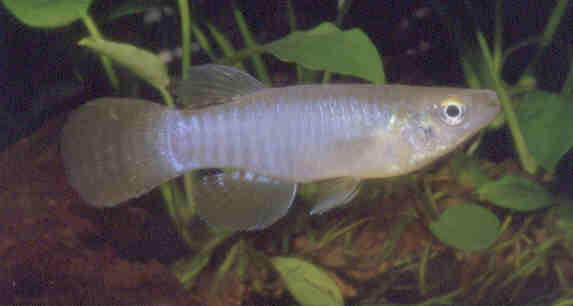Aplocheilichthys spilauchen (Duméril 1859)
CI 06. USA import. Photo courtesy of Tony Terceira.
| Meaning of Name |
|
|||
| First Description |
|
|||
| Size |
7 cm |
|||
| Meristics |
|
|||
| Karyotype |
|
|||
| Sub-Genus |
|
|||
| Group |
|
|||
| Synonyms |
|
|||
|
Populations
|
Cape Sierra - Collected by John Parker, Fred Wright & Rod Roberts in Sierra Leone in the early part of 1976. |
|||
| Type Locality |
|
|||
| Distribution |
|
|||
| Habitat |
Wide ranging habitats. Found in brackish lagoons & brackish mangrove swamps. |
|||
| Distinguishing Characteristics | ||||
| Colour/Pattern Variability | A deep bodied sp. with vertical lines in the rear half of the body. | |||
| History |
Boulenger gives the following collectors / locations in his 1915 Catalogue.
I am struck here by the collections of Miss Kingsley. Who was she & how did she become involved in collecting fish to the extent of supplying Boulenger in the early 1900's? History of the synonym Aplocheilichthys tschiloangensis (Ahl 1928) Described from Landama, Cabinda, Lower Congo. |
|||
| Breeding Notes |
A report appeared in BKA newsletter No.87, November
1972 in which marine salt was added to the strength of SG 1·006.
Eggs were laid in a bottom mop & were observed to be in clumps of
4-8. Eggs were taken out & incubated in a tub excluding light. Embryo
development was apparent at 4 days with hatching ocurring between 18-22
days. Newly hatched fry were observed rarely to leave the water surface
& swam awkwardly. Feeding presented problems as they seemed too
slow to catch newly hatched brine shrimp. It was observed they were
feeding from a surface scum. |
|||
| Diameter of Egg | 'Approaching' 2 mm | |||
| Remarks |
This sp. is particularly susceptible to velvet but will tolerate salt to brackish levels.. |

